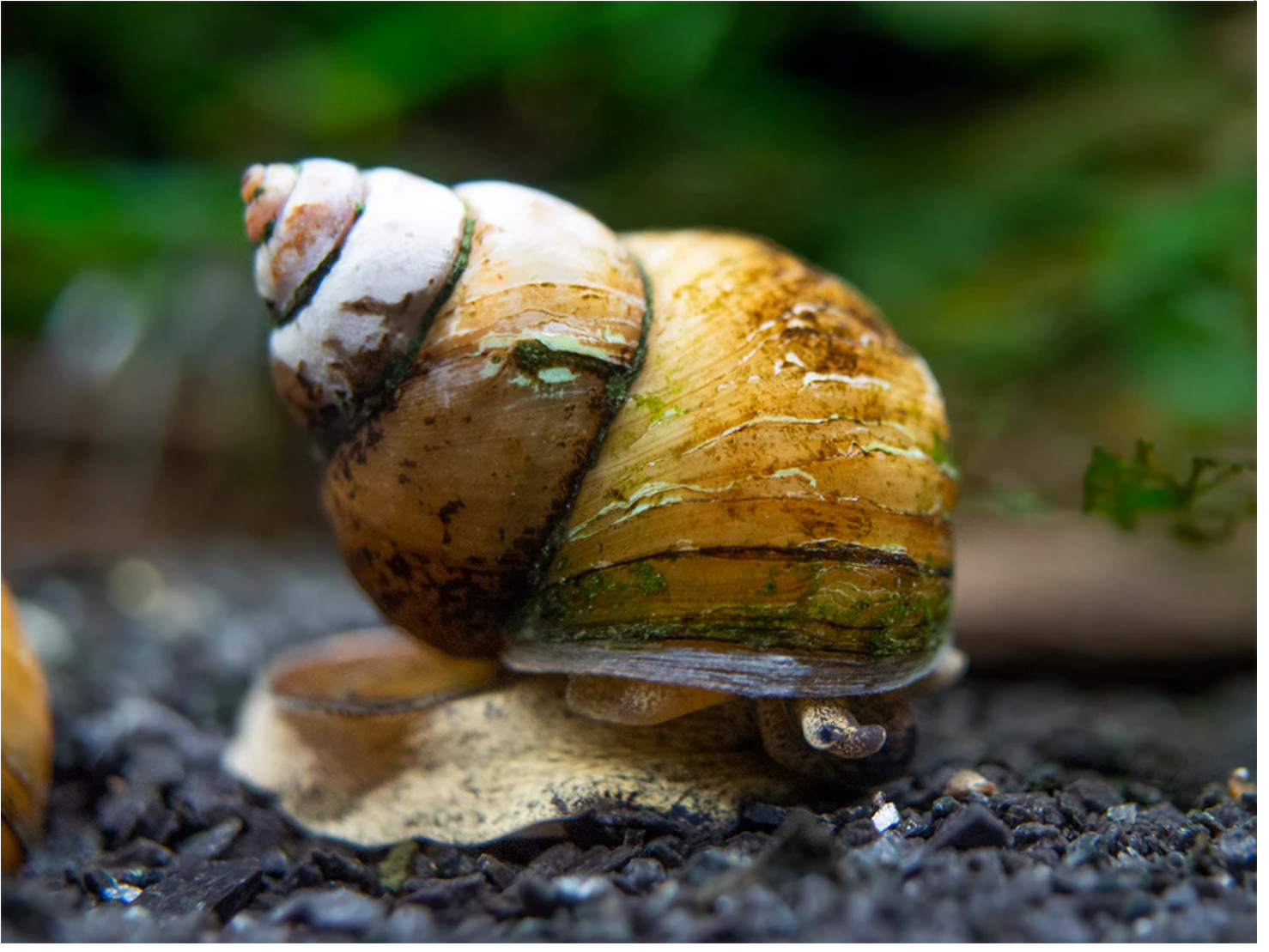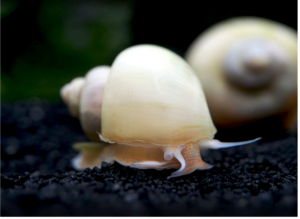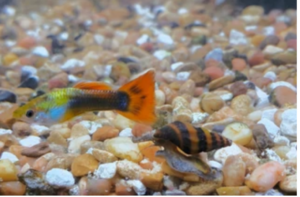The Japanese trapdoor snail is a popular choice among professional and recreational aquarists worldwide. This snail possesses an appealing appearance, serves a practical purpose, and is remarkably low-maintenance.
The Japanese trapdoor snail is a freshwater omnivore that consumes algae, decaying organic matter, and other tank inhabitants. It can grow up to 1.2 inches (3 cm) in diameter and 2 inches (5 cm) in length, making it suitable for aquariums with a minimum size of 10 gallons (38 liters).
This comprehensive guide provides valuable insights into the rearing of Japanese trapdoor snails. It covers essential topics such as tank setup, feeding, breeding, and potential issues that may arise with this species.
Origin and Habitat
There is often confusion surrounding the Japanese trapdoor snail, as it is frequently mistaken for the Chinese mystery snail. While physically resembling other mystery snail species, the Japanese trapdoor snail (Viviparus malleattus) sets itself apart through its unique reproduction and tank behavior.
These two snail species are erroneously considered the same in many pet stores and online resources. However, as we delve deeper into its intriguing characteristics, the distinctions between the Japanese trapdoor snail and other mystery snails will become clearer.
The Japanese trapdoor snail originated in Japan and gradually spread to eastern Asia and other parts of the world. It has established large populations in the following regions:
- Myanmar
- Thailand
- Japan
- China
The snail’s introduction to other regions primarily occurred through the fish trade. Over time, this species has rapidly expanded and is now recognized as one of the invasive snail species.
Unlike mystery snails, which breath through a siphon and modified lung, the Japanese trapdoor snail relies on gills for respiration. This unique breathing mechanism enables it to adapt well to cold climates, as it can survive in deeper waters where freezing is less likely.
In the wild, Japanese trapdoor snails thrive in dimly lit, slow-moving, or stagnant water. These environments are typically covered with a thick layer of mud, providing an ideal setting for vegetation growth.
Related Reading: Can Snails Breathe Underwater?
Appearance and Size
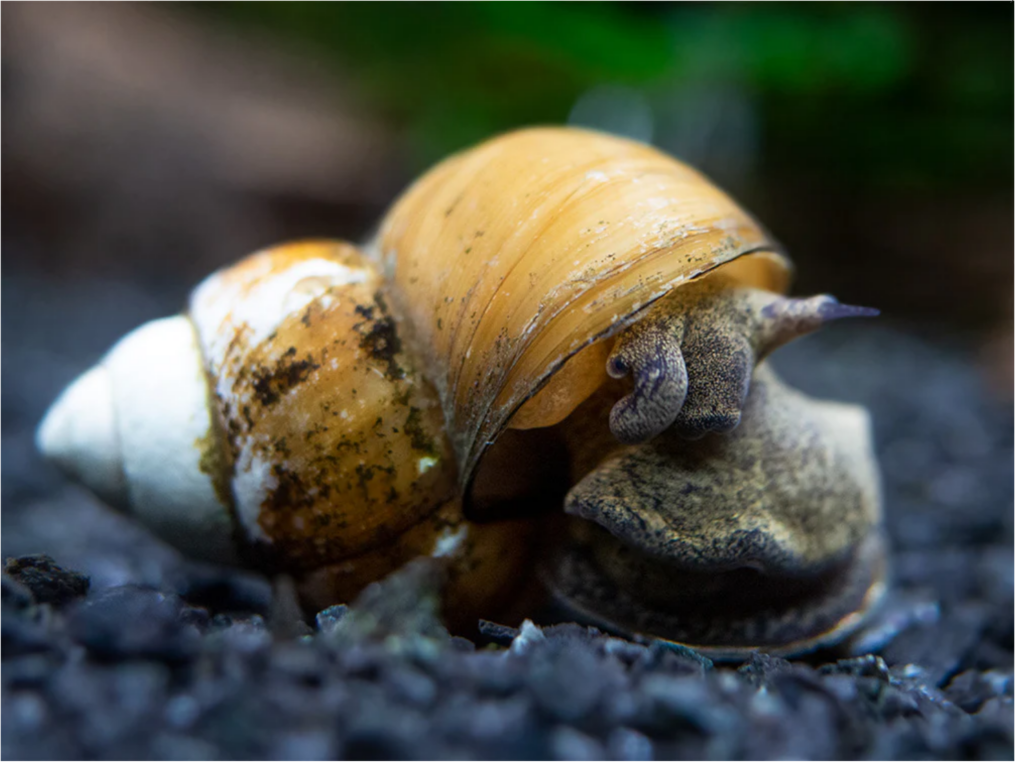
Japanese trapdoor snails exhibit a variety of colors, shapes, and sizes. Their shells are elongated and cone-shaped, with primary colors being the most prevalent.
The ones I’ve come across typically display shades of:
- Black
- Brown
- Dark green
Typically, the snail’s first whorl features a primary color that gradually transitions into lighter hues towards the rear. Additionally, it is common to find patches of white on the outer shell of these snails.
The Japanese trapdoor snail possesses an operculum, often called a trapdoor. This robust plate serves as a protective barrier, which the snail can close when faced with a threatening situation.
In captivity, Japanese trapdoor snails can grow to sizes ranging from 1.1-2 inches (2.8-5 cm) in diameter and 2-2.7 inches (5-6.9 cm) in length.
In the wild, they can reach even larger sizes. However, the snail’s size is influenced by factors such as:
- Age
- Tank conditions
- Diet
Japanese Trapdoor Snail vs. Mystery Snail
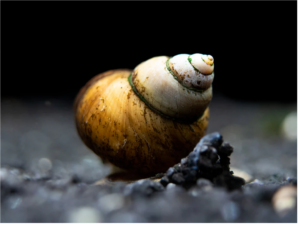
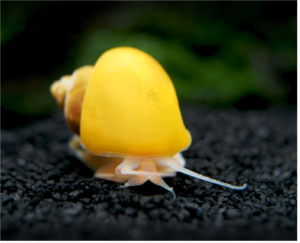
| Characteristic | Japanese Trapdoor Snail | Mystery Snail |
| Shell Size and Shape | Longer, spire-shaped shell | More rounded shell |
| Number of Whorls | 5-7 large, not tightly compressed whorls | 3-4 small, compressed whorls |
| Shell Appearance | Resembles an ice cream cone | Rounded in shape |
| Shoulder Width | Narrower | Broader |
| Body Size | Relatively smaller | Larger |
What sets the Japanese trapdoor snail apart from the mystery snail regarding physical characteristics? The key difference lies in their shell size and shape.
The Japanese trapdoor snail boasts a longer, spire-shaped shell resembling an ice cream cone. It consists of 5-7 large whorls that are not tightly compressed.
In contrast, mystery snails possess a more rounded shell with 3-4 small, compressed whorls. Furthermore, compared to the Japanese trapdoor snail, mystery snails have broader shoulders and larger bodies.
Japanese Trapdoor Snail Lifespan
Under captive conditions, the average lifespan of a Japanese trapdoor snail is around 3 years. However, scientists have achieved remarkable longevity with this species, successfully rearing them for up to 10 years.
It’s worth noting that Japanese trapdoor snails reach sexual maturity relatively late, typically around 18 months.
Buying Japanese Trapdoor Snails
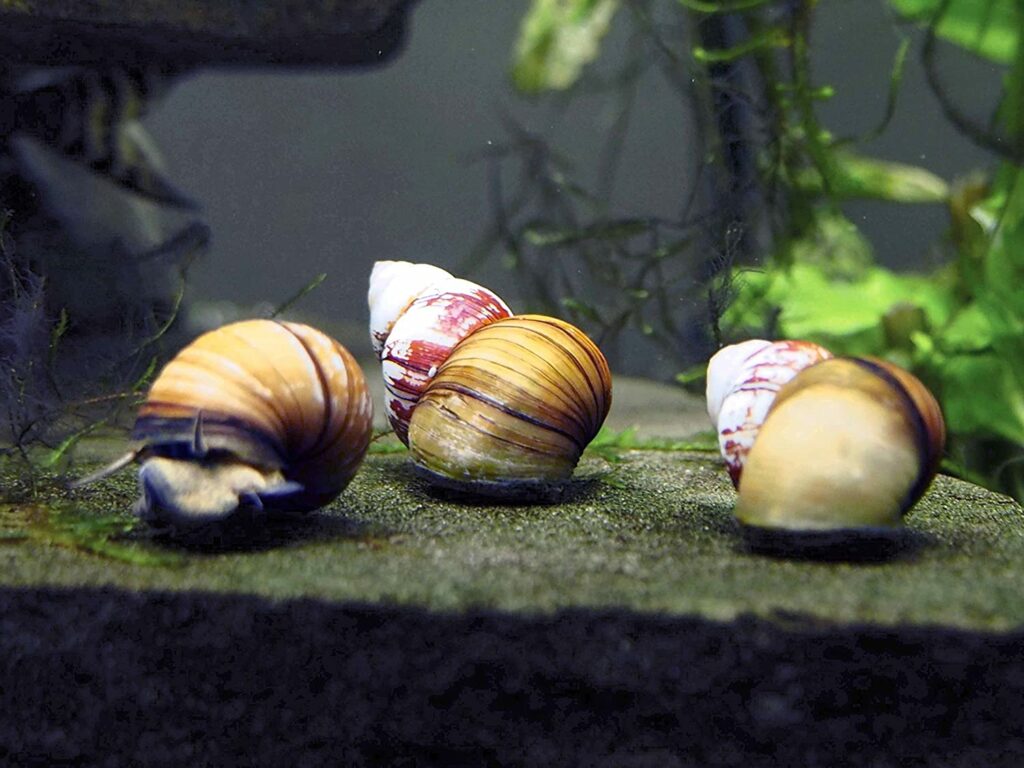
If you are in need of Japanese Trapdoor Snails, Aquatic Arts offer a package of 10 of these snails.
| Preview | Product | |
|---|---|---|

|
Aquatic Arts 10 Japanese Trapdoor Snails | Pond Snail/Freshwater Aquarium Clearer/Tetra Pond… | Check Price |
Ensure you have basic aquarium supplies, including a tank or pond filter like the TetraPond Filter. Aquatic Arts provides a 100% live arrival guarantee for all their plants and animals and free email support.
When purchasing Japanese trapdoor snails from a pet store, it’s important to be cautious as there is always a risk of obtaining unfit individuals. These unfit snails may die shortly after purchase or fail to develop properly and reach their optimal size.
To ensure a healthier selection, look for active snails that are visibly scavenging for food or firmly attached to hard tank surfaces.
However, remember that the Japanese trapdoor snail has been observed to spend extended periods completely enclosed in its shell, so not all dormant snails are necessarily sick. Nevertheless, for added assurance, prioritize active snails.
Also, inspect the shells for any cracks or deformities, as a healthy snail will have a shell free from such issues.
Lastly, consider opting for smaller-sized snails over large adults, as younger snails tend to have more vitality and are less prone to health problems.
Japanese Trapdoor Snail Care
Tank Setup
I recommend a minimum tank size of 2 gallons (7.6 liters) for a single Japanese trapdoor snail. However, if you aim to facilitate effective breeding, acquiring and maintaining approximately 5 trapdoor snails is advisable, necessitating a tank size of 10 gallons (38 liters) or larger.
I always stress the importance of larger tanks for snail keeping, as they are better equipped to handle fluctuations in water parameters. Allowing some free space within the tank is beneficial for the well-being of its inhabitants.
Related Reading: Do Snails Increase Bioload?
It’s crucial to consider that waste production occurs from all tank inhabitants, and overstocking can have severe consequences for the health of both snails and other tank dwellers.
An excellent tank option to consider for Japanese trapdoor snail rearing is the Aqueon Standard Glass 10-Gallon Tank from Amazon. This tank features a sleek rectangular design that can fit into tight spaces. Additionally, this tank is constructed from transparent and scratch-resistant materials.
| Preview | Product | |
|---|---|---|

|
Aqueon Standard Glass 10 Gallon Rectangular Tank for Aquariums & Terrariums | Check Price |
If you desire a larger population of snails, I recommend opting for a larger tank size of 20 or 30 gallons (76-114 liters).
In my experience, a 30-gallon tank is particularly favorable for snail breeding, as these critters reproduce rapidly. Within a year, you can expect over 30 snails in your tank. A 30-gallon tank is better equipped to handle such a population than limited survival chances in a 10-gallon tank.
The SeaClear 30-gallon Show Acrylic Aquarium Combo Set is a great option for a 30-gallon tank. This set includes a lighting system and a leveling mat for added support. It is also easy to assemble and clean.
The ideal water parameters for the Japanese trapdoor snail in any tank size are as shown in the table below:
| Water Parameters | Range |
| Temperature | 66 – 78°F (19 – 26°C) |
| pH | 7.0 – 8.0 |
| Water hardness | 4 – 8 kH |
| Lighting | Normal community tank lighting |
It’s important to note that this snail species is highly sensitive to water quality, particularly to copper and other heavy metals. Exercise caution when using fish medication, as many of them contain copper.
Related Reading: Can You Use ParaGuard with Snails?
To carefully monitor your tank parameters, I recommend using the SJ WAVE 7-in-1 Aquarium Test Kit from Amazon. This affordable and easy-to-use test kit provides fast and accurate results, allowing you to monitor pH, chlorine, general hardness, carbonate hardness, nitrate, nitrite, and temperature.
| Preview | Product | |
|---|---|---|

|
SJ WAVE 7 in 1 Aquarium Test Kit for Freshwater Aquarium | Fast & Accurate Water Quality Testing… | Check Price |
Additionally, it is advisable to have the Seachem Cuprisorb 100 ml copper and heavy metal removal kit. This absorbent effectively eliminates copper and other heavy metals from your tank. It is environmentally friendly, fast-acting, and easy to use.
| Preview | Product | |
|---|---|---|

|
Seachem Cuprisorb 100ml | Check Price |
Vegetation and Substratum
For the Japanese trapdoor snail, it is recommended to have adequate, but not excessive, vegetation and a soft, muddy substratum. An ideal combination for the tank substratum is Aqua soil mixed with soft fine sand.
Old decaying organic plant material serves as food for the Japanese trapdoor snail while supporting the tank ecosystem by promoting algae growth. The Japanese trapdoor snail will only consume plants if there is a scarcity of other food sources.
While decorations are not essential, they can enhance the visual appeal of the tank and provide additional surfaces for algae growth, expanding the food options for Japanese trapdoor snails.
However, it’s crucial to avoid overcrowding the tank. Due to their larger size, Japanese trapdoor snails may face difficulties navigating cluttered tanks.
Feeding
The Japanese trapdoor snail is an omnivore that will consume the following:
- Algae
- Decaying plant matter
- Fish food remnants
- Deceased tank inhabitants
The Japanese trapdoor snail is not a picky eater and will readily consume almost anything provided.
In the wild, these snails can easily find enough food, but scavenging for sufficient nourishment in captivity can be more challenging. Therefore, it is advisable to supplement their diet with additional foods.
Occasional offerings of the following can be provided:
- Blanched vegetables
- Algae wafers
- Fish food pellets
- Bottom feeder pellets
However, be cautious not to overfeed the tank, which can lead to nitrogen spikes. Calcium is vital to the snail’s diet for proper shell development.
While calcium-rich waste materials like eggshells and cuttlefish bones can be used, I recommend commercial calcium pellets. These pellets release calcium more readily and create less mess in the tank.
Consider using Seachem Reef Calcium 500 ml blend pellets, as they are easily accessible, easy to use, and highly effective in providing calcium to your tank.
- Liquid organic calcium source
- Maintains calcium and accelerates coral growth
- Concentrated (50,000 mg/L)
Breeding
The Japanese trapdoor snail has a slow breeding rate, so you won’t find yourself dealing with an overwhelming population in your tank.
These snails do not begin reproducing until they are 18 months old. They reproduce sexually, with the male depositing sperm on the female’s gonophore during mating.
Fertilization takes place, and the embryos begin to develop. These embryos grow inside special capsules within the mother’s brood pouches. This process, known as oviparity, offers the advantage of protecting the developed embryos.
Having the embryos develop inside the female provides a safer environment than leaving the eggs to hatch independently in the tank. After approximately 2 months, the embryos are born as pea-sized baby snails with visible shells.
Typically, the female gives birth to 5-15 baby snails at a time. A Japanese trapdoor snail can give birth up to 3 times a year. Still, in captivity, most individuals reproduce only twice a year.
Tank Mates
Japanese trapdoor snails can coexist peacefully with various fish and snail species. However, it’s important to avoid keeping them with the following as these can pose a threat and potentially eat the snails:
- Shrimps
- Loaches
- Aggressive fish
Here are some recommended tank mates for Japanese trapdoor snails:
- Cory Catfish
- Otocinclus Catfish
- Nerite Snails
- Ivory Snails
- Gold Inca Snails
- Ramshorn Snails
- Trumpet Snails
- Mystery Snails
Common Problems
One common issue with Japanese trapdoor snails is their tendency to try to escape from the tank, often resulting in injury and death. To prevent this, always make sure to keep your tank securely closed.
Another problem that these snails are prone to is Oedema, which causes swelling of the tissues, making the snail appear puffy and swollen. Unfortunately, there is little that can be done for snails with Oedema apart from isolating them in quarantine.
Additionally, when introducing new snails to your tank, be cautious of potential parasites and leeches that may be carried by these snails from pet stores. These can spread to your healthy Japanese trapdoor snails, so taking precautions is important.
Related Reading: Can Snails Get Fish TB?
Closing Remarks
The Japanese trapdoor snail is often confused with mystery snails but has distinct differences. It is smaller and lacks a siphon, which differentiates it from mystery snails.
The Japanese trapdoor snail is an excellent tank cleaner that efficiently scavenges organic matter and is relatively easy to maintain. Additionally, its slow breeding rate reduces the risk of it becoming invasive.
With all the necessary care elements covered, it’s time for you to consider adding Japanese trapdoor snails to your tank and start your snail-keeping hobby.
I appreciate any feedback to improve this page, and I’m here to answer any snail-keeping-related questions. Feel free to drop a comment below.
